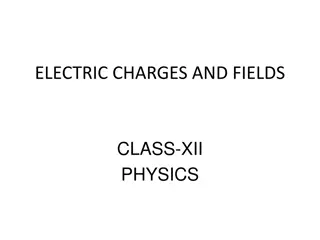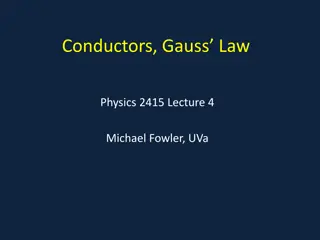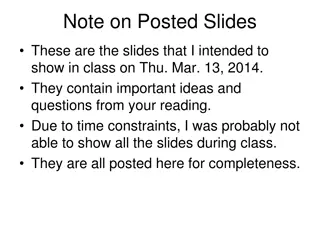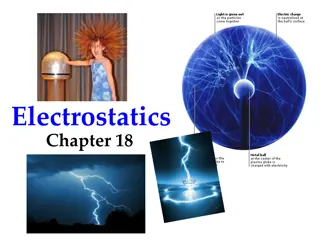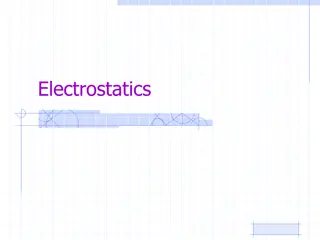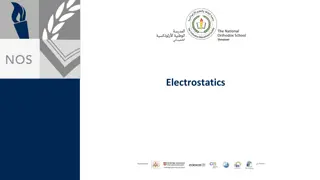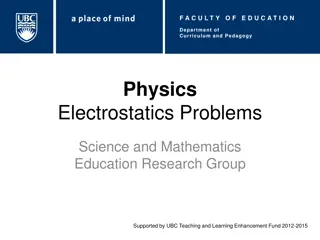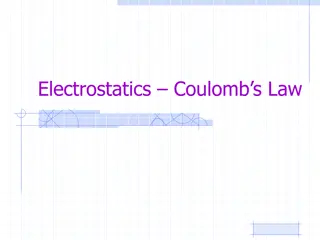Insights into Electrostatics
Unveil the secrets of electrostatics, exploring concepts like electrostatic potential in conductors, energy systems, two-dimensional problems, forces on conductors, and properties of dielectrics. Understand the behavior of charges and fields in various scenarios.
Download Presentation

Please find below an Image/Link to download the presentation.
The content on the website is provided AS IS for your information and personal use only. It may not be sold, licensed, or shared on other websites without obtaining consent from the author.If you encounter any issues during the download, it is possible that the publisher has removed the file from their server.
You are allowed to download the files provided on this website for personal or commercial use, subject to the condition that they are used lawfully. All files are the property of their respective owners.
The content on the website is provided AS IS for your information and personal use only. It may not be sold, licensed, or shared on other websites without obtaining consent from the author.
E N D
Presentation Transcript
EDII quizzes 2023
The electrostatic potential inside of a conductor is zero increases with distance from the center decreases with distance from the center is constant The electrostatic potential in a universe that contains only conductors and vacuum can take maximum and minimum values only at infinity only at the boundaries between a conductor and vacuum only at the center of the conductors only midway between different conducting bodies
The electrostatic energy of a system of charged conductors in vacuum is positive definite Can be positive or negative Is negative like the mechanical energy of planets The quantities Cab with a not equal to b are called coefficients of electrostatic induction coefficients of capacity mutual capacitance
Two dimensional problems of electrostatics are conveniently solved by the method of images the method of conformal mapping the method of inversion The method of images tries to find fictitious point charges to make the mathematical surface of the conductor have Group of answer choices zero potential constant potential a minimum potential
Electrostatic forces on the surfaces of conductors are zero because the surface is an equipotential are always outwards from and normal to the conductor might not be normal if there are other charged conductors might be outward or inward depending on the sign of the charge The net force on a conductor with zero net charge in a uniform external field is positive is zero depends on the distribution of positive and negative charges is negative
The normal component of the electric field at the surface of a dielectric is proportional to the normal component of the polarization the polarization charge density the total surface charge density the extraneous surface charge density The normal component of the electric induction at the surface of a dielectric is proportional to the extraneous surface charge density the total surface charge density the normal component of the polarization the polarization charge density
The electric dipole moment of a dielectric body in an external electric field is NOT proportional to the polarizability the total electric field the volume of the body the electric field that would be present if the dielectric were absent differentials of the internal energy and the free energy of a dielectric are related to each other by Legendre transform Laplace transform Laguerre transform L'Hopital transform
At the interface between two conductors, which quantity is continuous? The normal component of the current density the normal component of the electric field the tangential component of the current density the tangential component of the electric induction When the magnetic field changes sign, the symmetric part of the conductivity tensor must vanish changes sign is unchanged is complex conjugated
The units of surface current density are charge/(time*area) charge/(time*volume) charge/(time*length) charge/time At the boundary between two different media we must have normal component of H continuous normal component of B continuous tangential component of B continuous tangential component of M continuous
In comparing magnetic and electric energies, the mathematical analogue of the electric potential is the charge density electric field vector potential current density In comparing the electric and magnetic energies, the mathematical analogue of the vector potential is the current density scalar potential charge density magnetic field
The magnetization of most bodies in an external magnetic field is small. In that case, the magnetic energy of the body equals the magnetic energy of the field produced by the given external currents in the volume of the body if the body was absent times 4 times the magnetic permeability the temperature the magnetic susceptibility In vacuum, the sign of the free energy of the magnetic field "script F tilda" is the magnetization could have either sign negative positive
Inductances are the coefficients of proportionality between the currents which produce the magnetic field and the magnetic fluxes circuit area magnetic field induced electric field Self-inductance is proportional to the dimension of the conductor is independent of the shape of the conductor depends on the current in the conductor depends on the magnetic field the conductor is in.
In the self inductance of a linear ciruit, the external part is comparable to the internal part Is negligible and be ignored makes the main contribution is identically zero due to time reversal symmetry For a closed linear circuit, the self-inductance diverges logarithmically is constant through out space is zero because the current returns to the same point is finite
The magnetic induction inside a superconductor is always... zero infinity indeterminate the same as the H-field Any electric current that flows in a superconductor is a surface current a combination of surface and volume current a volume current infinte
The quasistatic approximation applies to any kind of solid dielectrics conductors For the quasistatic approximation to be valid, the field frequency must be solids and viscous liquids large compared to vibrational frequencies of ions in the lattice small compared to the reciprocal relaxation time of free electrons small compared to the orbital frequency of bound electrons large compared to the reciprocal mean free time of electrons
Eddy currents are caused by thermal conduction electric fields of an incident electromagnetic wave induced electric fields from variable magnetic fields that penetrate into a conductor acceleration of the body The magnetic field penetration depth in the quasistatic approximation proportional to inverse of frequency is proportional to frequency has frequency dependence that depends on whether the penetration depth is large or small is proportional to inverse square root of frequency
In the expansion of the impedance in powers of frequency, the term linear in frequency is proportional to the circuit's self inductance resistance EMF current The real part of the impedance... is positive is negative can be positive or negative is zero
The frequency of undamped oscillations in an LCR circuit depends on L and C L and C and R R and C R and L The capacitive part of the impedance varies as (w=frequency) C L/ R 1/ C /LC
Consider two actions. 1. A conductor moves within a constant magnetic field. 2 A conductor is stationary in a field that changes with time. Which effects can generate an emf. both neither the second the first For a moving conductor in a static magnetic field, an emf appears only if the conductor crosses lines of magnetic field every point of the conductor moves along a line of force the conductor is doubly connected the conductor spins on its axis
At frequencies much greater than 4 Pi sigma/epsilon, a material behaves as a crystal a conductor a dielectric a semimetal In conductors at low frequencies, the displacement current is more important than conduction current approaching a constant limiting value diverging negligible
At frequencies that approach the natural frequencies of motion that causes polarization, the electric induction is determined by the electric field at every previous instant at future instants not at all at the present moment only At high frequencies, the distinction between dielectrics and conductors becomes more pronounced disappears remains unchanged No answer text provided.
As frequency approaches infinity, the permittivity tends to unity infinity negative values zero When frequency exceeds the natural frequencies of electrons in a conductor or dielectric, the electrons behave as though strongly interacting with the nuclei bound free strongly interacting with each other
The rate of change of energy in unit volume of a body is div S S curl S The total energy dissipated by a non-monochromatic pulse of electromagnetic energy a non-magnetic dispersive medium is proportional to S2 the positive part of the permittivity spectrum the imaginary part of the permittivity the real part of the permeability the real part of the permittivity
For dielectrics the function f(), that tells how much the electric fields at earlier times a distance into the past contribute to the induction at the present time, tends to zero as tau becomes large. For metals, the function that tends to zero is f minus a constant times.... the conductivity the dissipated energy the permeability the permittivity The complex permittivity is a function of the complex frequency. The permittivity is real on which axis of the complex frequency plane? positive real negative imaginary negative real positive imaginary
The real part of the permittivity at a given frequency can be calculated from knowledge of the imaginary part of the permittivity at all frequencies the imaginary part of the permittivity at the same frequency The imaginary part of the permittivity at zero frequency the real part of the permittivity at zero frequency The oscillator strength is proportional to the real part of the permittivity the imaginary part of the permittivity the inverse of the frequency the square root of the spring constant
A wave for which k' and k" are not in the same direction is called a homogeneous plane wave an inhomogeneous plane wave an isotropic plane wave an anisotropic plane wave The real part of of the permittivity ' is related to the real and imaginary parts of the complex index n + ik by ' = 2nk ' = k^2-n^2 =2n/k =n^2 - k^2







